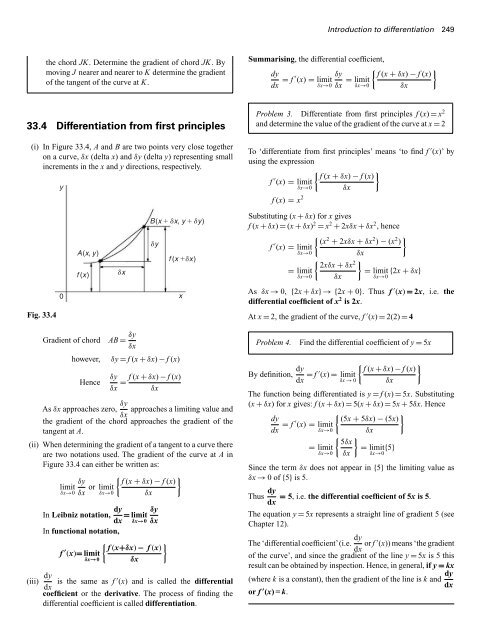basic_engineering_mathematics0
Create successful ePaper yourself
Turn your PDF publications into a flip-book with our unique Google optimized e-Paper software.
Introduction to differentiation 249<br />
the chord JK. Determine the gradient of chord JK. By<br />
moving J nearer and nearer to K determine the gradient<br />
of the tangent of the curve at K.<br />
Summarising, the differential coefficient,<br />
{ }<br />
dy<br />
dx = f ′ δy f (x + δx) − f (x)<br />
(x) = limit<br />
δx→0 δx = limit<br />
δx→0 δx<br />
33.4 Differentiation from first principles<br />
(i) In Figure 33.4, A and B are two points very close together<br />
on a curve, δx (delta x) and δy (delta y) representing small<br />
increments in the x and y directions, respectively.<br />
Fig. 33.4<br />
y<br />
A(x, y)<br />
f (x)<br />
dx<br />
B(x dx, y dy)<br />
dy<br />
0 x<br />
Gradient of chord<br />
however,<br />
Hence<br />
AB = δy<br />
δx<br />
δy = f (x + δx) − f (x)<br />
f (x dx)<br />
δy f (x + δx) − f (x)<br />
=<br />
δx δx<br />
As δx approaches zero, δy approaches a limiting value and<br />
δx<br />
the gradient of the chord approaches the gradient of the<br />
tangent at A.<br />
(ii) When determining the gradient of a tangent to a curve there<br />
are two notations used. The gradient of the curve at A in<br />
Figure 33.4 can either be written as:<br />
{ }<br />
δy f (x + δx) − f (x)<br />
limit or limit<br />
δx→0 δx δx→0 δx<br />
In Leibniz notation, dy<br />
dx = limit δy<br />
δx→0 δx<br />
In functional notation,<br />
{ }<br />
f (x+δx) − f (x)<br />
f ′ (x)= limit<br />
δx→0 δx<br />
(iii) dy<br />
dx is the same as f ′ (x) and is called the differential<br />
coefficient or the derivative. The process of finding the<br />
differential coefficient is called differentiation.<br />
Problem 3. Differentiate from first principles f (x) = x 2<br />
and determine the value of the gradient of the curve at x = 2<br />
To ‘differentiate from first principles’ means ‘to find f ′ (x)’ by<br />
using the expression<br />
{ }<br />
f (x + δx) − f (x)<br />
f ′ (x) = limit<br />
δx→0 δx<br />
f (x) = x 2<br />
Substituting (x + δx) for x gives<br />
f (x + δx) = (x + δx) 2 = x 2 + 2xδx + δx 2 , hence<br />
{ (x<br />
f ′ 2 + 2xδx + δx 2 ) − (x 2 }<br />
)<br />
(x) = limit<br />
δx→0<br />
δx<br />
{ 2xδx + δx<br />
2<br />
}<br />
= limit<br />
= limit {2x + δx}<br />
δx→0 δx<br />
δx→0<br />
As δx → 0, {2x + δx} → {2x + 0}. Thus f ′ (x) = 2x, i.e. the<br />
differential coefficient of x 2 is 2x.<br />
At x = 2, the gradient of the curve, f ′ (x) = 2(2) = 4<br />
Problem 4.<br />
Find the differential coefficient of y = 5x<br />
By definition, dy<br />
{ }<br />
f (x + δx) − f (x)<br />
dx = f ′ (x) = limit<br />
δx → 0 δx<br />
The function being differentiated is y = f (x) = 5x. Substituting<br />
(x + δx) for x gives: f (x + δx) = 5(x + δx) = 5x + 5δx. Hence<br />
{ }<br />
dy<br />
(5x + 5δx) − (5x)<br />
dx = f ′ (x) = limit<br />
δx→0<br />
= limit<br />
δx→0<br />
δx<br />
{ } 5δx<br />
= limit<br />
δx<br />
{5}<br />
δx→0<br />
Since the term δx does not appear in {5} the limiting value as<br />
δx → 0of{5} is 5.<br />
Thus dy = 5, i.e. the differential coefficient of 5x is 5.<br />
dx<br />
The equation y = 5x represents a straight line of gradient 5 (see<br />
Chapter 12).<br />
The ‘differential coefficient’(i.e. dy<br />
dx or f ′ (x)) means ‘the gradient<br />
of the curve’, and since the gradient of the line y = 5x is 5 this<br />
result can be obtained by inspection. Hence, in general, if y = kx<br />
(where k is a constant), then the gradient of the line is k and dy<br />
dx<br />
or f ′ (x)=k.















![[Lonely Planet] Sri Lanka](https://img.yumpu.com/59845622/1/169x260/lonely-planet-sri-lanka.jpg?quality=85)

